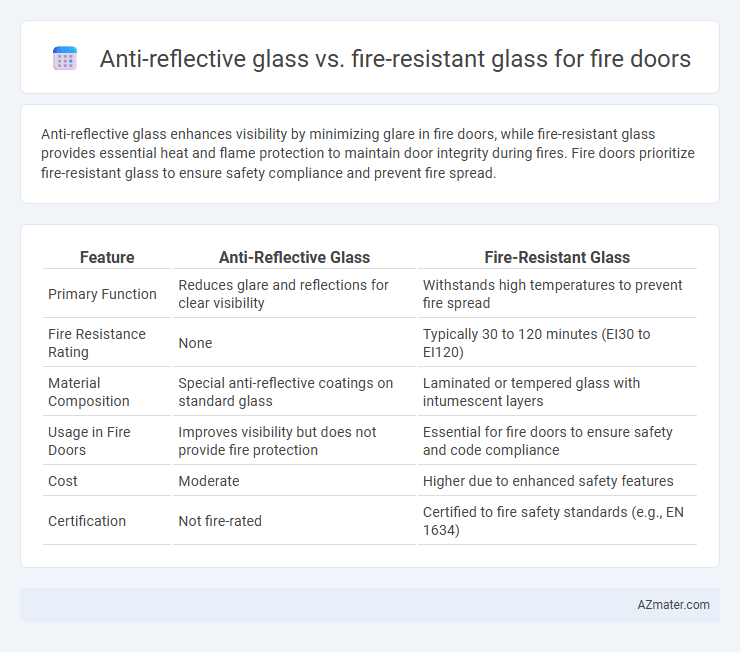Anti-reflective glass enhances visibility by minimizing glare in fire doors, while fire-resistant glass provides essential heat and flame protection to maintain door integrity during fires. Fire doors prioritize fire-resistant glass to ensure safety compliance and prevent fire spread.
Table of Comparison
| Feature | Anti-Reflective Glass | Fire-Resistant Glass |
|---|---|---|
| Primary Function | Reduces glare and reflections for clear visibility | Withstands high temperatures to prevent fire spread |
| Fire Resistance Rating | None | Typically 30 to 120 minutes (EI30 to EI120) |
| Material Composition | Special anti-reflective coatings on standard glass | Laminated or tempered glass with intumescent layers |
| Usage in Fire Doors | Improves visibility but does not provide fire protection | Essential for fire doors to ensure safety and code compliance |
| Cost | Moderate | Higher due to enhanced safety features |
| Certification | Not fire-rated | Certified to fire safety standards (e.g., EN 1634) |
Introduction to Fire Door Glazing Solutions
Fire door glazing solutions require materials that combine safety and functionality, where anti-reflective glass enhances visibility by reducing glare, improving security monitoring. Fire-resistant glass provides critical protection by withstanding high temperatures and preventing fire spread, meeting stringent safety standards like BS 476 or UL 9. Selecting the appropriate glass balances optical clarity with fire performance, ensuring both optimal visibility and compliance in fire door installations.
What Is Anti-Reflective Glass?
Anti-reflective glass is specially coated to minimize surface reflections, enhancing visibility and clarity through fire doors by reducing glare and improving light transmission. This type of glass is designed to maintain a clear view while ensuring safety features are uncompromised, making it ideal for environments requiring both transparency and fire resistance. Compared to fire-resistant glass, which primarily focuses on heat and flame protection, anti-reflective glass emphasizes optical performance without sacrificing essential fire door standards.
What Is Fire-Resistant Glass?
Fire-resistant glass is engineered to withstand high temperatures and prevent the spread of fire and smoke, making it essential for fire doors in commercial and residential buildings. Unlike anti-reflective glass, which primarily reduces glare and enhances visibility, fire-resistant glass contains layers that insulate and maintain structural integrity during exposure to fire. This type of glass meets strict building codes and fire safety standards, providing both protection and durability in critical safety applications.
Key Differences: Anti-Reflective vs Fire-Resistant Glass
Anti-reflective glass for fire doors primarily reduces glare and improves visibility by minimizing surface reflections, enhancing aesthetic and functional clarity without compromising safety. Fire-resistant glass is engineered to withstand high temperatures and prevent the spread of flames and smoke for a specific duration, meeting stringent fire safety standards such as UL 10C or EN 13501-2. The key difference lies in their core functionality: anti-reflective glass focuses on optical performance, while fire-resistant glass prioritizes thermal insulation and structural integrity during fire exposure.
Safety Standards for Fire Door Glass
Fire door glass must comply with stringent safety standards such as UL 9 and EN 13501-2 to ensure fire resistance and integrity during high heat exposure. Anti-reflective glass primarily enhances visibility and reduces glare but typically lacks the required fire-resistance certification essential for fire door applications. Fire-resistant glass is engineered to withstand extreme temperatures and prevent flame penetration, meeting specific fire rating classifications critical for protecting occupants and property.
Visual Performance in Fire Door Applications
Anti-reflective glass in fire doors enhances visual clarity by minimizing glare and reflections, ensuring maximum visibility and safer evacuation during emergencies. Fire-resistant glass prioritizes thermal protection and fire containment while maintaining adequate transparency to meet safety codes without compromising structural integrity. Selecting the optimal glass balances visual performance with fire safety standards to optimize occupant safety and fire door functionality.
Durability and Maintenance Considerations
Anti-reflective glass for fire doors offers enhanced visibility and reduced glare with moderate durability, requiring regular cleaning to maintain clarity and performance. Fire-resistant glass prioritizes safety, providing superior durability under high temperatures and minimal maintenance due to its robust construction and ability to withstand thermal stress. Choosing between them hinges on balancing the need for visual clarity against stringent fire safety standards and long-term maintenance efficiency.
Cost Comparison: Anti-Reflective vs Fire-Resistant Glass
Anti-reflective glass generally costs less than fire-resistant glass due to its simpler manufacturing process and primary function of reducing glare rather than providing fire protection. Fire-resistant glass is significantly more expensive because it must meet stringent safety standards and undergo specialized treatments to withstand high temperatures and prevent fire spread. Installation costs for fire-resistant glass tend to be higher as well, reflecting its critical role in fire door safety and compliance with building codes.
Best Use Cases for Each Glass Type
Anti-reflective glass in fire doors is ideal for commercial buildings and retail spaces where maximum visibility and natural light are essential without glare, enhancing safety and aesthetics. Fire-resistant glass is best suited for high-risk environments like hospitals, laboratories, and industrial facilities, where maintaining fire containment and preventing smoke spread are critical. Each glass type serves specific safety needs: anti-reflective glass prioritizes visibility and style, while fire-resistant glass ensures compliance with fire safety regulations and protection.
Choosing the Right Glass for Fire Doors
Choosing the right glass for fire doors requires understanding the distinct properties of anti-reflective glass and fire-resistant glass. Fire-resistant glass is specifically engineered to withstand high temperatures and prevent the spread of fire, meeting stringent safety standards such as ASTM E119 or BS 476. Anti-reflective glass enhances visibility and reduces glare but lacks the critical fire protection qualities necessary for fire door applications.

Infographic: Anti-reflective glass vs Fire-resistant glass for Fire door
 azmater.com
azmater.com